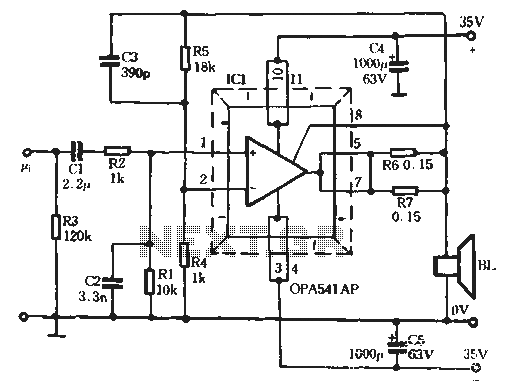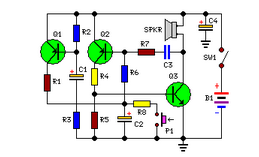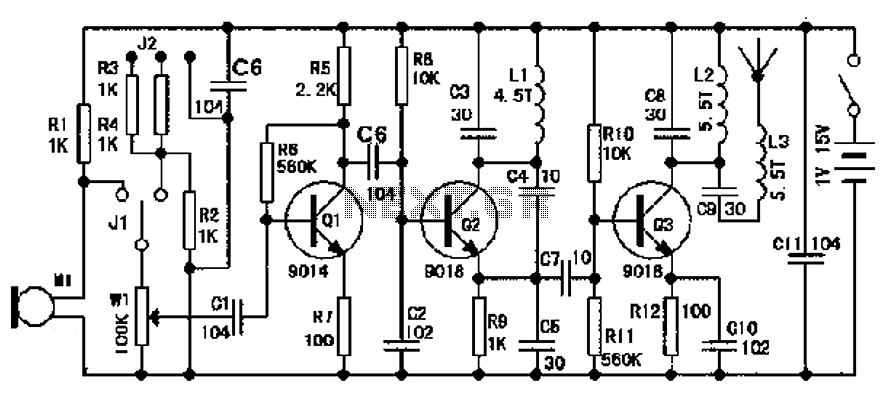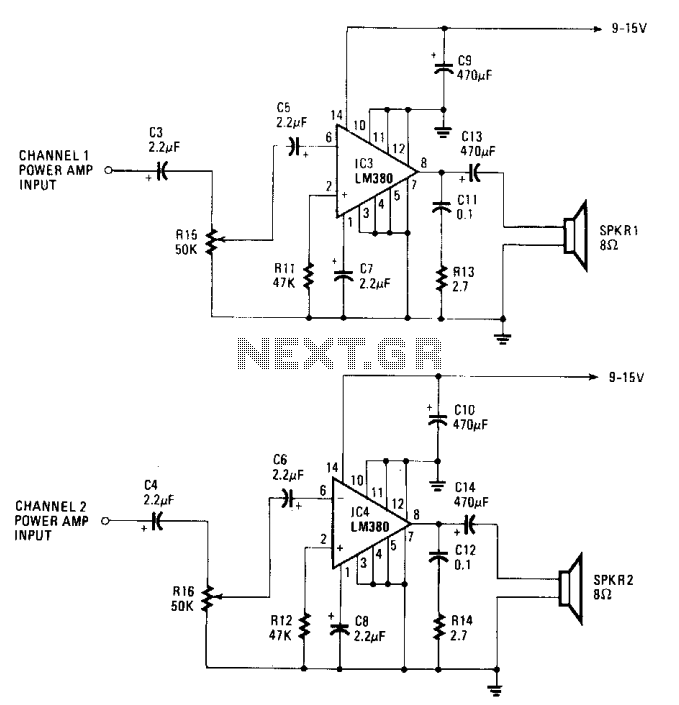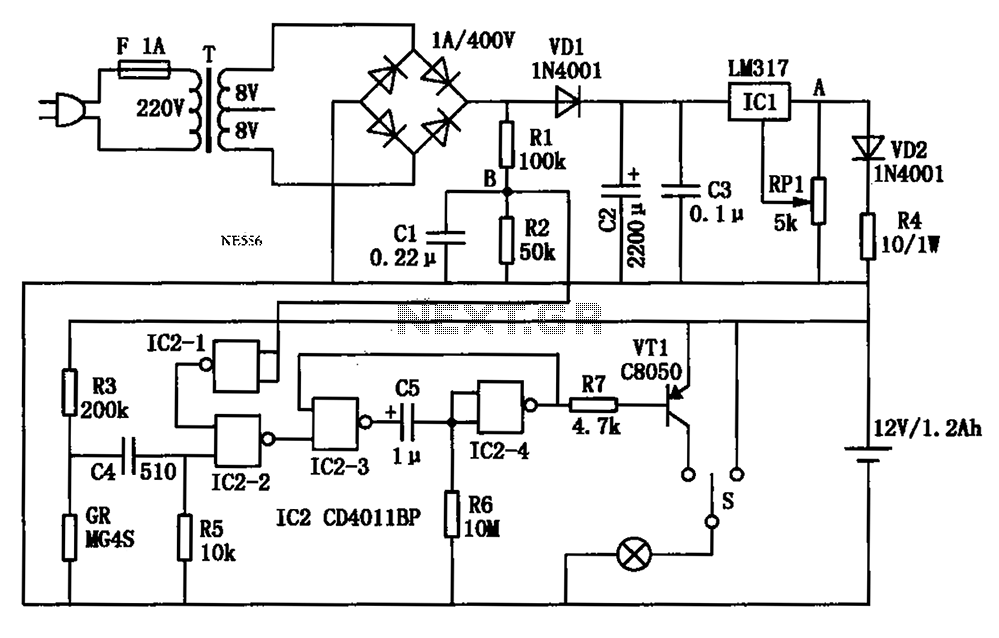
Schematic Diagram 300W Power Amplifier For Subwoofer
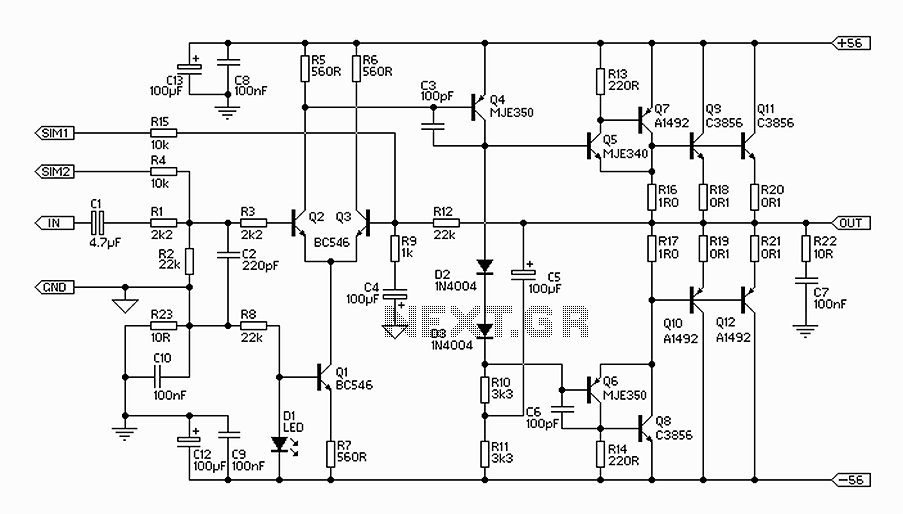
The 300W amplifier circuit presented is a conventional design. It includes connections for the internal SIM and incorporates filtering for RF protection (R1, C2). The input is facilitated through a 4.7µF bipolar capacitor, which offers substantial capacitance in a compact form. Due to the impedance characteristics, there will be minimal degradation of sound quality. Alternatively, a polyester capacitor can be utilized; a 1µF capacitor with a nominal 22k input impedance will yield a -3dB frequency of 7.2Hz, sufficient for subwoofer applications. The continuous power output into an 8-ohm load is typically over 150W (250W for ±70V supplies), allowing operation at full power without the need for additional transistors. Extra transistors are only required for similar performance into a 4-ohm load at maximum supply voltage. While the circuit features MJL4281A and MJL4302A output transistors, these may be difficult to source. Suitable alternatives include MJL3281/MJL1302 or MJL21193/MJL21194. This amplifier operates in a "pure" Class-B configuration, which may lead to higher high-frequency distortion, rendering it less ideal for high-power hi-fi applications. However, at low frequencies, significant negative feedback is present, resulting in relatively low distortion of approximately 0.04% up to 1kHz. Initial tests and feedback from users suggest that there are no audible artifacts at high frequencies.
The 300W amplifier circuit is designed for high performance in audio amplification applications, particularly suited for driving subwoofers. The use of a 4.7µF bipolar capacitor at the input stage ensures that the amplifier maintains a compact design while providing sufficient capacitance to handle low-frequency signals effectively. The choice of a polyester capacitor as an alternative allows for flexibility based on component availability and personal preference, while still ensuring that the amplifier can achieve a -3dB frequency response suitable for subwoofer applications.
The amplifier's capability to deliver over 150W into an 8-ohm load, and up to 250W with ±70V supply voltages, demonstrates its robustness for continuous operation. The design's reliance on additional transistors is minimal, only necessary for applications requiring 4-ohm loads, which speaks to the circuit’s efficiency and reliability in various audio setups.
The output stage, featuring MJL4281A and MJL4302A transistors, is a critical component of the amplifier's performance. While these transistors may not always be readily available, the recommended alternatives—MJL3281/MJL1302 or MJL21193/MJL21194—provide similar performance characteristics, ensuring that builders can source components without compromising the circuit's integrity.
Operating in a "pure" Class-B configuration, the amplifier is expected to exhibit higher distortion at high frequencies, which may limit its application in high-fidelity audio systems. However, the significant negative feedback implemented at lower frequencies helps to maintain distortion levels around 0.04% up to 1kHz, making it suitable for bass-heavy audio applications. Observations from initial testing indicate a lack of audible artifacts at high frequencies, reinforcing the amplifier's performance reliability for subwoofer applications. Overall, this circuit design presents a balanced approach to audio amplification, prioritizing both power output and sound quality within its operational parameters.The 300W Amplifier circuit is shown it is a reasonably conventional design. Connections are provided for the Internal SIM, and filtering is provided for RF protection (R1, C2). The input is via a 4. 7uF bipolar cap, as this provides lots of capacitance in a small size. Because of the impedance, little or no degradation of sound will be apparent. A polyester cap may be used if you prefer - 1uF with the nominal 22k input impedance will give a -3dB frequency of 7. 2Hz, which is quite low enough for any sub. Continuous power into 8 ohms is typically over 150W (250W for ±70V supplies), and it can be used without additional transistors at full power into an 8 ohm load all day, every day.
The additional transistors are only needed if you want to do the same thing into 4 ohms at maximum supply voltage Although I have shown MJL4281A and MJL4302A output transistors, because they are new most constructors will find that these are not as easy to get as they should be. The alternatives are MJL3281/ MJL1302 or MJL21193/ MJL21194. Because this amplifier circuit operates in "pure" Class-B (something of a contradiction of terms, I think), the high frequency distortion will be relatively high, and is probably unsuited to high power hi-fi.
At the low frequency end of the spectrum, there is lots of negative feedback, and distortion is actually rather good, at about 0. 04% up to 1kHz. My initial tests and reports from others indicate that there are no audible artefacts at high frequencies, but the recommendation remains.
🔗 External reference
The 300W amplifier circuit is designed for high performance in audio amplification applications, particularly suited for driving subwoofers. The use of a 4.7µF bipolar capacitor at the input stage ensures that the amplifier maintains a compact design while providing sufficient capacitance to handle low-frequency signals effectively. The choice of a polyester capacitor as an alternative allows for flexibility based on component availability and personal preference, while still ensuring that the amplifier can achieve a -3dB frequency response suitable for subwoofer applications.
The amplifier's capability to deliver over 150W into an 8-ohm load, and up to 250W with ±70V supply voltages, demonstrates its robustness for continuous operation. The design's reliance on additional transistors is minimal, only necessary for applications requiring 4-ohm loads, which speaks to the circuit’s efficiency and reliability in various audio setups.
The output stage, featuring MJL4281A and MJL4302A transistors, is a critical component of the amplifier's performance. While these transistors may not always be readily available, the recommended alternatives—MJL3281/MJL1302 or MJL21193/MJL21194—provide similar performance characteristics, ensuring that builders can source components without compromising the circuit's integrity.
Operating in a "pure" Class-B configuration, the amplifier is expected to exhibit higher distortion at high frequencies, which may limit its application in high-fidelity audio systems. However, the significant negative feedback implemented at lower frequencies helps to maintain distortion levels around 0.04% up to 1kHz, making it suitable for bass-heavy audio applications. Observations from initial testing indicate a lack of audible artifacts at high frequencies, reinforcing the amplifier's performance reliability for subwoofer applications. Overall, this circuit design presents a balanced approach to audio amplification, prioritizing both power output and sound quality within its operational parameters.The 300W Amplifier circuit is shown it is a reasonably conventional design. Connections are provided for the Internal SIM, and filtering is provided for RF protection (R1, C2). The input is via a 4. 7uF bipolar cap, as this provides lots of capacitance in a small size. Because of the impedance, little or no degradation of sound will be apparent. A polyester cap may be used if you prefer - 1uF with the nominal 22k input impedance will give a -3dB frequency of 7. 2Hz, which is quite low enough for any sub. Continuous power into 8 ohms is typically over 150W (250W for ±70V supplies), and it can be used without additional transistors at full power into an 8 ohm load all day, every day.
The additional transistors are only needed if you want to do the same thing into 4 ohms at maximum supply voltage Although I have shown MJL4281A and MJL4302A output transistors, because they are new most constructors will find that these are not as easy to get as they should be. The alternatives are MJL3281/ MJL1302 or MJL21193/ MJL21194. Because this amplifier circuit operates in "pure" Class-B (something of a contradiction of terms, I think), the high frequency distortion will be relatively high, and is probably unsuited to high power hi-fi.
At the low frequency end of the spectrum, there is lots of negative feedback, and distortion is actually rather good, at about 0. 04% up to 1kHz. My initial tests and reports from others indicate that there are no audible artefacts at high frequencies, but the recommendation remains.
🔗 External reference
